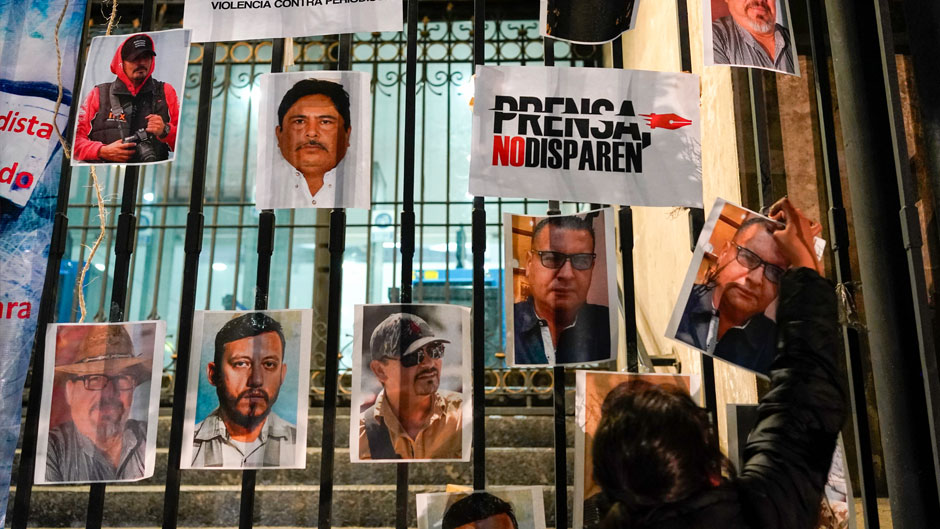Mexico continues to be one of the most dangerous places for journalists to practice their profession. Four journalists were killed since the start of this year, prompting large street demonstrations in almost 40 cities in the country by angry news people who are demanding justice for their fallen colleagues.
In early January, journalist Jose Luis Gamboa was stabbed to death in Veracruz state. And two others killed were from Tijuana, an area that is plagued with drug violence as rival cartels compete for power. Margarito Martinez, 49, a photographer and crime reporter, was killed near his home on Jan. 17. And Lourdes Maldonado Lopez, a 67-year-old local television personality, was shot in her car as she arrived home on Jan. 23.
On Monday, a fourth news person was killed. Roberto Toledo, a 55-year-old who worked in a law office, was shot dead in a garage in Zitácuaro in the state of Michoacán, where he also worked for the local online news outlet Monitor Michoacan.
In the past three years, 32 journalists have been murdered in Mexico, according to the Committee to Protect Journalists—making it one of the deadliest places for journalists outside of war zones.
Another was attacked last Wednesday. Jose Ignacio Santiago narrowly escaped when a car carrying armed assailants tried to cut his vehicle off on a rural highway in the southern state of Oaxaca.
Sallie Hughes, associate dean for global initiatives and professor in the School of Communication at the University of Miami, has done extensive research on the plight of Mexican journalists.
“This does not seem to end, and I worry that as long as there is no punishment, the killing of journalists is being normalized,” she said of the recent deaths.
There has been a history of impunity when it comes to the violence against journalists, according to Hughes. Many journalists who cover crime, corruption, and the drug trade are threatened and intimidated not only by criminals but often by police officers and people in government, she stated.
The government set up a state-run mechanism in 2012 to protect journalists in the country, but there have been reports that the agency is understaffed and underfunded.
At the time of her death, Maldonado was under state protection. During a news conference in 2019, she had appealed to Mexican president Andrés Manuel López Obrador saying that she feared for her life.
Hughes also pointed out that there seems to be a “lack of political will” to end the violence. The president of Mexico must have the political will and democratic values to protect journalists even if he doesn’t always like what they have to say, she declared.
“There are two things that López Obrador can do right now,” the scholar listed. “Empower the special prosecutors to professionally investigate and charge anyone who attacks a journalist. Make that a priority. Ending impunity now begins to break the cycle,” she said. “The second thing is to beef up the capacity of the protection mechanism, and make sure it is not penetrated by anyone who is corrupt.”
Even though many Mexican journalists work under precarious and often dangerous conditions, they express a strong sentiment that their work is important. Hughes’ research shows that journalists who are most threatened are those who voice a strong commitment to report and publish news and to hold those in power accountable.
“Their tenacity and bravery come from a deep dedication to the public service mission of journalism. They are banding together to take safety training, report collaboratively, and to protest publicly to demand government protection,” said Hughes. “There are international entities such as UNESCO, Reporters without Borders, and the Committee to Protect Journalists that also take up their cause and pressure the government to do more.”
Hughes is a member of a group called The Worlds of Journalism Study, a consortium of more than 100 universities around the world. She and others formed the Mexico study network of eight universities in 2018 with support from the University’s Institute for Advanced Study of the Americas. The country teams are conducting research based on common methodologies to understand journalists’ working conditions around the world, including risk and precarity, and hope to make the knowledge available to policymakers, international organizations, and fellow journalists.
The group issued a letter last Thursday condemning the killings in Mexico. “Violence against journalists, in addition to attacking and silencing people who practice this profession, violates freedom of expression and citizens' right to information. It is violence that progressively consolidates zones of silence in which people who practice journalism, at the risk of being harmed, cannot communicate about the problems of their community, thus canceling the right of citizens to be informed and act accordingly. All this brings with it profound risks for the democratic life of our country,” a part of the letter stated.
Get more information about the global and Mexico research networks at worldsofjournalism.org and https://www.worldsofjournalismmexico.org.mx.

